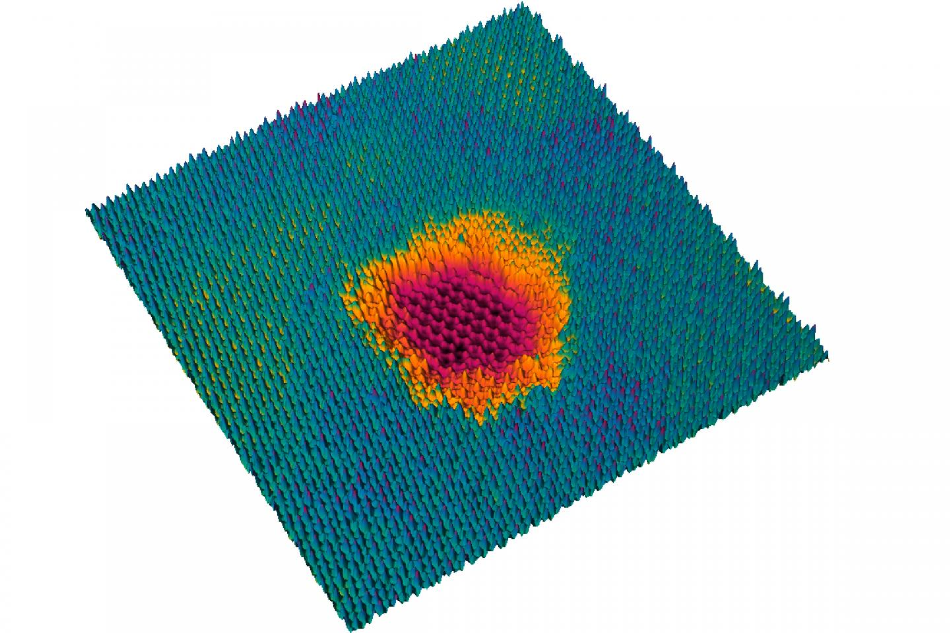Aug 4 2020
Researchers (TU Wien) (Vienna) have developed a nano-structuring method that can be employed to perforate specific layers of a material in a highly precise way, while others are left completely unaltered, although the projectile penetrates all layers.
 The projectile penetrates all layers, but only in the top layer, a big hole is created. The graphene below remains intact. Image Credit: TU Wien.
The projectile penetrates all layers, but only in the top layer, a big hole is created. The graphene below remains intact. Image Credit: TU Wien.
They achieved this by using highly charged ions that can be employed to selectively process the surfaces of novel 2D material systems, for instance, to bind specific metals on them, which can subsequently act as catalysts. The new technique was recently reported in the ACS Nano journal.
New Materials from Ultra-Thin Layers
Materials made of numerous ultra-thin layers are considered an interesting new field in the area of materials research. Since the first production of the high-performance material graphene, comprising only a single layer of carbon atoms, various new thin-film materials have been creating, typically with potential new properties.
We investigated a combination of graphene and molybdenum disulfide. The two layers of material are brought into contact and then adhere to each other by weak van der Waals forces. Graphene is a very good conductor, molybdenum disulphide is a semiconductor, and the combination could be interesting for the production of new types of data storage devices.
Dr Janine Schwestka, Study First Author, Institute of Applied Physics, TU Wien
However, in some applications, the material’s geometry must be particularly processed on the nanoscale—for instance, to modify the chemical properties by combining different types of atoms or to manipulate the optical properties of the surface.
“There are different methods for this,” noted Janine Schwestka. “You may modify the surfaces with an electron beam or with a conventional ion beam. With a two-layer system, however, there is always the problem that the beam affects both layers at the same time, even if only one of them is supposed to be modified.”
Two Kinds of Energy
While using an ion beam to treat a surface, the material is often influenced by the force of the impacting ions. However, the TU Wien researchers used relatively slow ions that are multiply charged.
Two different forms of energy must be distinguished here. On the one hand, there is the kinetic energy, which depends on the speed at which the ions impact on the surface. On the other hand, there is the potential energy, which is determined by the electric charge of the ions. With conventional ion beams, the kinetic energy plays the decisive role, but for us the potential energy is particularly important.
Richard Wilhelm, Professor, TU Wien
Both the forms of energy have an important difference between them: The kinetic energy is liberated in both material layers while penetrating the layer system, but the potential energy could be distributed in a highly uneven way between the layers.
Richard Wilhelm added, “The molybdenum disulfide reacts very strongly to the highly charged ions. A single ion arriving at this layer can remove dozens or hundreds of atoms from the layer. What remains is a hole, which can be seen very clearly under an electron microscope.”
By contrast, the graphene layer hit by the projectile immediately afterward stays intact: a major portion of the potential energy has already been liberated.
It is possible to also reverse the same experiment such that the highly charged ion first hits the graphene before hitting the molybdenum disulfide layer. Here, both layers tend to stay intact: the graphene offers the required electrons to the ion to neutralize it electrically within a small fraction of a second.
The electrons in graphene have such high mobility that the point of impact also “cools down” instantly. While crossing the graphene layer, the ion does not leave a permanent trace. Then, it cannot cause much damage to the molybdenum disulfide layer.
“This provides us now with a wonderful new method for manipulating surfaces in a targeted manner,” added Richard Wilhelm. “We can add nano-pores to surfaces without damaging the substrate material underneath. This allows us to create geometric structures that were previously impossible.”
Thus, “masks” can be created from molybdenum disulfide perforated precisely as desired, on which atoms of specific metal are subsequently deposited. This paves the way for entirely new possibilities for manipulating the chemical, optical, and electronic properties of the surface.
We are very pleased that our excellent collaborations via the TU Doctoral College TU-D were able to contribute significantly to these results. In addition, it distinguishes Vienna as a location for science and research that we were able to establish contacts with the University of Vienna through short distances in order to deepen our joint expertise and complement each other methodically.
Janine Schwestka, TU Wien
Schwestka was a member of the TU-D for over three years.
Journal Reference:
Schwestka, J., et al. (2020) Atomic-Scale Carving of Nanopores into a van der Waals Heterostructure with Slow Highly Charged Ions. ACS Nano. doi.org/10.1021/acsnano.0c04476.